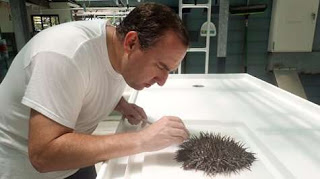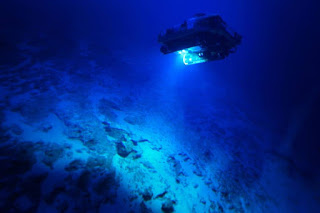Shark bong sparks outrage, Piracy in the high seas, High seas piracy grows, Himalayas melting, Shark fin soup pushback continues, and more …
1. ‘Humans Need To Do Better’: An Australian Fisherman’s Viral ‘Shark Bong’ Draws Outrage, Death Threats
The man sits patiently on the deck of a boat as if waiting for a cue. Pounding pop music that sounds vaguely like the foreboding “Jaws” theme song plays loudly in the background. Suddenly, a child starts singing, and at that exact moment, the man ducks his head toward the object resting on his knees — a small shark that appears to be dead with two short pipes protruding from its body. “Baby shark, doo doo doo doo doo doo,” the child sings, as the man brings a lighter to the pipe jutting out of the shark’s head, inhaling deeply from the other one located behind its dorsal fin.
———————————————–
 “Two-thirds of the world’s surface is ocean. Nearly all of that is beyond any State’s territorial waters and largely not subject to a single state criminal jurisdiction,” Yury Fedotov, Executive Director of the UN Office on Drugs and Crime (UNODC) said as he briefed the Council’s first-ever debate targeting the global challenge of transnational maritime crime. Speaking via video conference from UNODC headquarters in Vienna, he spotlighted the root causes of transnational organized crime at sea and the linkages between terrorism, piracy and illegal trafficking.
“Two-thirds of the world’s surface is ocean. Nearly all of that is beyond any State’s territorial waters and largely not subject to a single state criminal jurisdiction,” Yury Fedotov, Executive Director of the UN Office on Drugs and Crime (UNODC) said as he briefed the Council’s first-ever debate targeting the global challenge of transnational maritime crime. Speaking via video conference from UNODC headquarters in Vienna, he spotlighted the root causes of transnational organized crime at sea and the linkages between terrorism, piracy and illegal trafficking.
3. Climate Change Will Even Change the Color of the Oceans, Study Says
 The ocean will not look the same color in the future. It won’t turn pink or anything radically different; the change will be more apparent through optic sensors than though the human eye. But it serves as an early warning sign that global warming is significantly altering the planet’s ecosystems, according to a new study. Essentially, climate change will make the blues of the ocean bluer and the greens greener. Scientists figured this out by creating a global model that simulates the growth of a tiny creature that lives in the oceans and affects the color we see. Their research was published Monday in the journal Nature Communications.
The ocean will not look the same color in the future. It won’t turn pink or anything radically different; the change will be more apparent through optic sensors than though the human eye. But it serves as an early warning sign that global warming is significantly altering the planet’s ecosystems, according to a new study. Essentially, climate change will make the blues of the ocean bluer and the greens greener. Scientists figured this out by creating a global model that simulates the growth of a tiny creature that lives in the oceans and affects the color we see. Their research was published Monday in the journal Nature Communications.
4. Voyage Into the Unknown Explores Indian Ocean’s Hidden Depths, Assessing Pollution and Seeking New Life
A mission to explore uncharted depths in the Indian Ocean was launched on Wednesday, hoping to discover hundreds of new species and find out what impact plastic is having way below the surface. The First Descent expedition, led by British-based ocean research institute Nekton, is set to send submersibles as deep as 3,000 meters off the Seychelles from March to test the health of the ocean. The project was launched at the Commonwealth headquarters in London. “The mission is focusing on 30 meters down to 3,000 meters. This is where you get the peak diversity of species,” said Professor Alex Rogers, part of the scientific team.
5. Toxic Delicacy of Shark Fin Causes Ecosystem Chaos, and Consumers Are Pushing Back

Hong Kong (CNN)Adeline Chan’s nose crinkled at the market’s pungent, briny smell. Chan and her mother were once regulars at Hong Kong’s Dried Seafood Market, in Sheung Wan, where endless stalls display plastic bins stuffed with various forms of dried shark fin.
“We don’t need shark fins for ourselves, but sharks need their fins,” said Chan, now a vegan. “I stopped consuming shark fin soup four years ago after learning what sharks had to go through before a bowl of shark fin soup is served.”

Antarctica and Greenland aren’t the Earth’s only frozen places threatened by human-caused climate change: The Himalayas are also at risk, scientists announced Monday. In fact, a whopping two-thirds of Himalayan glaciers could melt by 2100 if global warming continues, according to the new report. Such a catastrophic melt would disrupt the flow of Asian rivers, which are a crucial resource for crops for billions of people in China, India and six other countries. “This is the climate crisis you haven’t heard of,” said Philippus Wester, a scientist with the International Centre for Integrated Mountain Development, which released the report. “Global warming is on track to transform the frigid, glacier-covered mountain peaks … to bare rocks in a little less than a century,” he said in a statement.
 Jonathan Allen has good news and bad news for Australians regarding the crown-of-thorns sea star. The bad news is that the fecund and voracious destroyer of Indo-Pacific coral reefs has a previously unknown method of reproduction. The good news is that the Australians might be able to limit the outbreaks of these coral-munching echinoderms by using this new knowledge. Allen is an associate professor in William & Mary’s Department of Biology. He is a member of a team that discovered that the crown-of-thorns seastar (COTS) can reproduce by larval cloning. Their discovery is described in “Larval cloning in the crown-of-thorns sea star, a keystone coral predator,” published in the journal Marine Ecology Progress Series.
Jonathan Allen has good news and bad news for Australians regarding the crown-of-thorns sea star. The bad news is that the fecund and voracious destroyer of Indo-Pacific coral reefs has a previously unknown method of reproduction. The good news is that the Australians might be able to limit the outbreaks of these coral-munching echinoderms by using this new knowledge. Allen is an associate professor in William & Mary’s Department of Biology. He is a member of a team that discovered that the crown-of-thorns seastar (COTS) can reproduce by larval cloning. Their discovery is described in “Larval cloning in the crown-of-thorns sea star, a keystone coral predator,” published in the journal Marine Ecology Progress Series.





